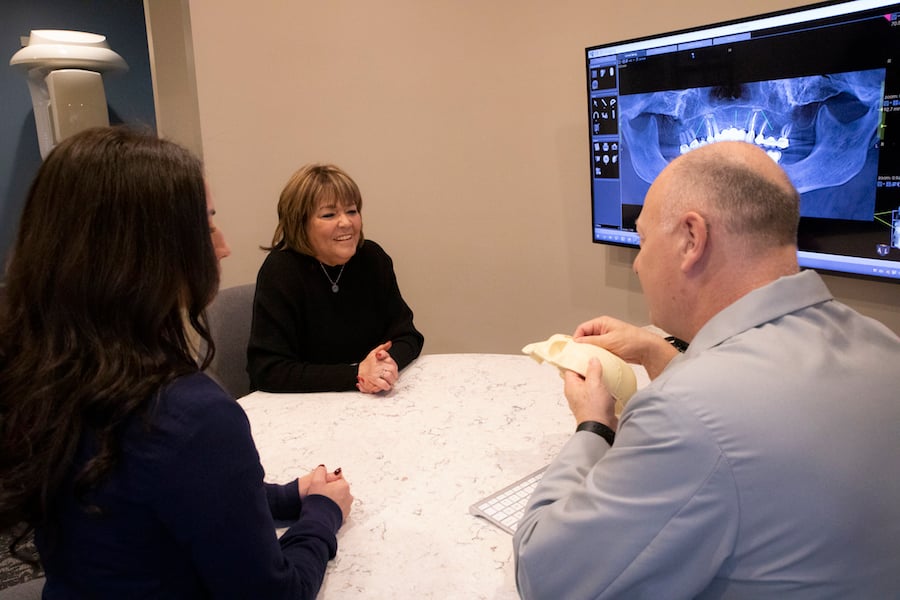A tooth extraction typically occurs when you have a severely decayed, cracked, infected, or broken tooth. Depending on various oral health factors, your dentist or oral surgeon might also recommend a bone graft after the extraction. Most tooth extraction patients do not even know whether it is necessary for their case. This brief overview looks at whether you will need to undergo bone grafting after your tooth extraction.
What is dental bone grafting?
Dental bone grafting is the process of filling a bone cavity in your jaw area around an extracted tooth using graft materials. This replaces bone loss by adding density and volume to your jaw. It also gives the gum tissue, bone, and skin room to grow around the area. The materials used for grafting depend on the type of procedure you undergo.
To fill a tooth socket, dentists or oral surgeons use graft material made of human or animal bone. However, at times synthetic materials are used. Types of bone grafting materials include:
- Autografts. These are the types of materials taken from your own body, such as from your tongue, gum tissue, and jaw.
- Allografts. They come from a human tissue bank.
- Xenografts. These are taken from animals like cows.
- Alloplastics. Synthetic materials like carbon fiber, ultra-high molecular weight (UHMW) polyethylene.
Do you need bone grafting after tooth extraction?
The need for bone grafting and other procedures after tooth extraction depend on varied factors. These include:
1) The type of tooth you have extracted. Typically, extraction of molar teeth is severe and increases the need for a bone graft.
2) The number of teeth extracted. If you have multiple teeth extracted, it can expose your jawbone to the risk of damage. Your oral surgeon would then suggest an additional procedure like bone grafting to protect the health of your jaw bone. In most cases, single tooth extraction may not require bone grafting. However, sometimes the severity of extraction and bone structure you have might necessitate it.
3) Bad root canal procedure. If you had a previous faulty root canal procedure, it could lead to tooth infection. The infection may spread to the jawbone and affect the bone structure. In such circumstances, your oral surgeon would suggest a bone grafting procedure after surgery to protect your jaw's health.
4) Bone cavities. If you had a bone cavity before the tooth extraction, your dentist or oral surgeon might suggest a bone graft to prevent the loss of bone tissue due to the surgery.
5) The surrounding teeth are affected by the extractions. If the extraction procedure causes damage to your surrounding teeth, you will need to undergo bone grafting in addition to the tooth extraction.
6) The bone structure in the extraction area. If the area around or underneath your teeth is weak, you will need bone grafting to protect your jaw.
7) Your overall health. It includes whether you have diabetes or blood clotting issues. These conditions can increase bleeding during and after the extraction process.
8) History of facial trauma. If you have experienced facial trauma in the past, your oral surgeon may recommend bone grafting to ensure that your jaw functions well.
Your oral surgeon may also recommend a bone graft if there isn't enough natural bone in your jaw to support the implant of the crown or bridge.
What does bone grafting do?
A successful bone graft procedure results in new blood vessels, bone cells, and gum tissue growth. The outcome after treatment would be a fully functional jaw from which you can eat and speak just like before. This is why you must find a competent dentist or oral surgeon to complete it in a timely and effective manner.
How is the bone graft procedure carried out?
The bone grafting procedure requires surgery at both the extraction site and at another part of your jaw to prepare the area for the new bone tissue. The surgery is carried out under local anesthesia and may take one day and sometimes over several procedures. This period of surgery depends on the sinus, nerve position, anatomy, or level of infection.
What are the benefits of bone grafting?
There are several benefits to undergoing a successful bone grafting procedure. These include:
- Preservation of your jawbone. After tooth extraction, the supporting bone structure dies. A successful grafting procedure helps to reduce the effects of this damage and prevent further loss of a healthy jawbone.
- Increases the bone density for healthier jaws. In addition to adding blood vessels and other cells, the new tissue forms a stronger connection between the jaw and surrounding teeth. It prevents further damage to the bone after surgery, making your treatment more efficient.
- Enhances the appearance of your facial features. Bone grafting also enhances your facial appearance after the extraction. This is because a successful procedure can restore a functional jaw and enable you to speak and eat with ease.
What is the cost of bone grafting?
The average cost for a bone grafting procedure without insurance coverage ranges from $2,500 to $3,500. However, for most people, it is covered and paid for by their insurance company. In such instances, you need to find a dentist or oral surgeon where your insurance coverage is accepted.
Recovery time and longevity of the procedure
The average healing time after bone grafting is between 3 and 9 months. However, you will feel normal in about two weeks. The bone grafting procedure is a long-term solution for your entire jaw, and it will provide you with stability and support.
The amount of prep work before the procedure
The amount of prep work depends on the complexity of your condition. For instance, you may need to clean the area before surgery if there is an infection or gum disease present. You might also need to remove the remaining tooth roots in the area of extraction if they are impacted. Existing restorations may also need to come off before the procedure.
To prepare for the procedure:
1) Inform your dentist or oral surgeon of any medication you are on at the time
2) Notify your dentist or oral surgeon of any illnesses you have, including blood clotting disorders, which can increase your risk of experiencing complications after the extraction
3) Reschedule if you have just come down with a cold, flu, or any other infection
4) Let your dentist or oral surgeon know of any allergies you have to medication
At North Shore Smile Surgery, we have over 30 years of experience in implementing this procedure for our patients. We offer complete dental care, so you can achieve the smile you have always wanted. We have an elite team of dental professionals to take care of all your dental needs. Our procedures include:
- Dental implants
- Full arch reconstruction
- Tooth extraction
- Dental bone grafting
- Oral surgery
We provide a comfortable atmosphere for you during your procedures and ensure that you receive the best care. If you need advice and information on how to take care of your jaw as you recover after the surgery, we will provide it. Schedule your appointment with us today and get the best dental care available.





